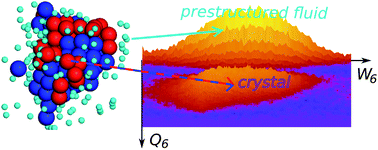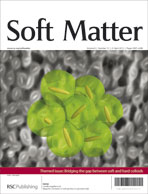Selection mechanism of polymorphs in the crystal nucleation of the Gaussian core model
Abstract
The principle of polymorph selection upon crystal nucleation is one of the fundamental problems in crystallization. Recently we found that for hard spheres the crystal polymorph is already selected by locally favoured packing symmetry in a metastable supercooled state. Here we study whether this scenario is also valid for soft spheres. To do so, we investigate the homogeneous nucleation process of the Gaussian core model (GCM) in supercooled states by means of Monte Carlo computer simulations. We use bond orientational order parameters, which characterize local packing symmetries, to follow the formation of solid nuclei and to distinguish between different polymorphs. We concentrate on two state points, at low and high pressure respectively, for which macroscopic thermodynamics dictates the formation of the different polymorphs (fcc and bcc crystals respectively). We show that the nucleation of the different crystalline structures does not follow Ostwald's step rule of crystallization, and that, despite the underlying phase diagram, the bcc phase is always favoured. In analogy to hard sphere systems, we find a new criterion for polymorph selection: crystallization occurs in precursor regions of high bond orientational order, and the crystal which first nucleates is the one that has the closest symmetry to these ordered regions in the supercooled state.

- This article is part of the themed collection: Bridging the gap between soft and hard colloids

 Please wait while we load your content...
Please wait while we load your content...